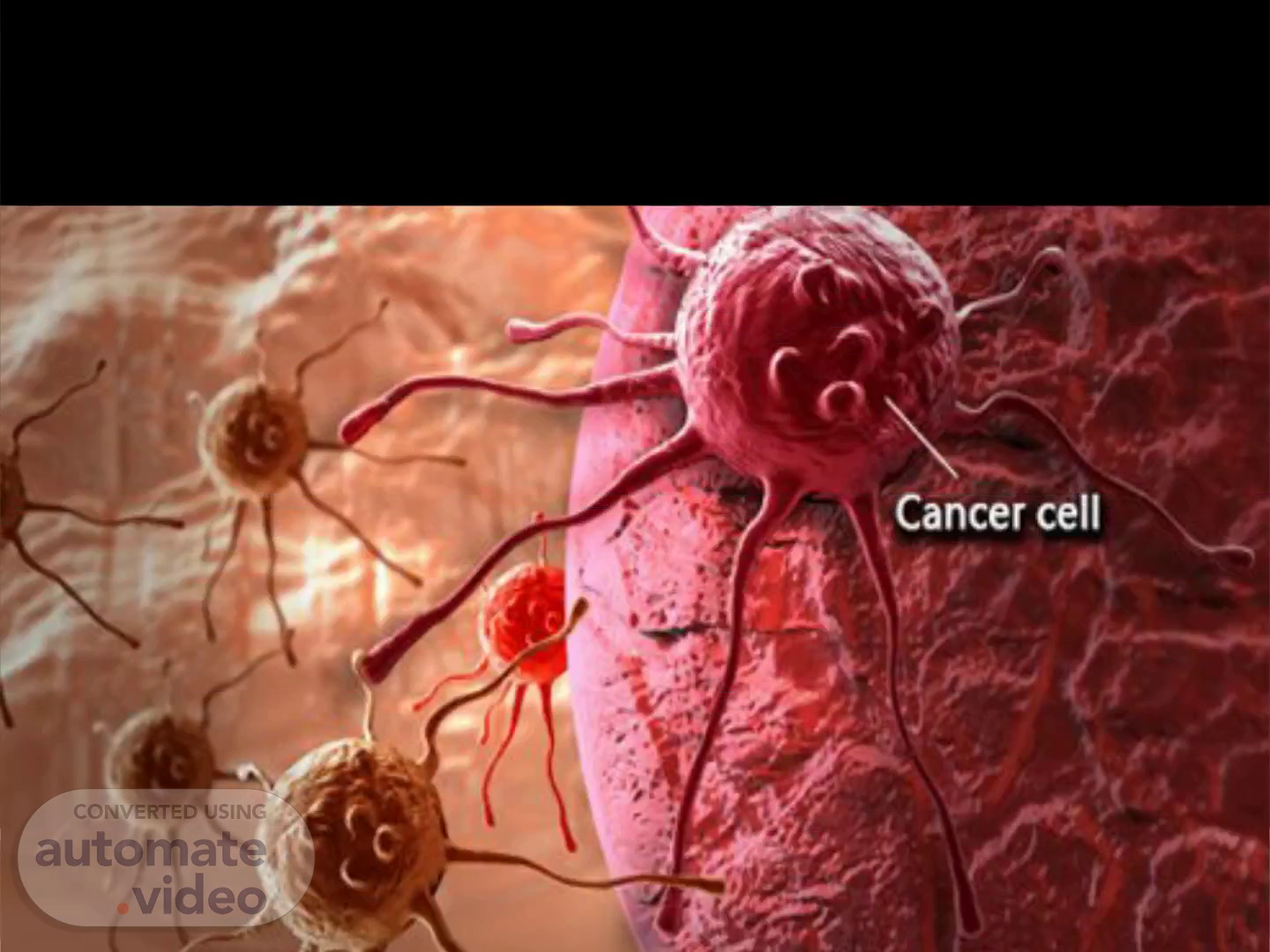
CANCER BY Balogun rukayat omolayo (2010042112) Shodipo oyinkansola damilola (2010042113) Bello oluwabukola temiloluwa (2010042048) Ogundimu motunrayo kabirat (2010042139) Alade kehinde oluwasodayo (2010042138) DEPARTMENT :MICROBIOLOGY COURSE: CCE 300 LE
Scene 1 (0s)
CANCER BY Balogun rukayat omolayo (2010042112) Shodipo oyinkansola damilola (2010042113) Bello oluwabukola temiloluwa (2010042048) Ogundimu motunrayo kabirat (2010042139) Alade kehinde oluwasodayo (2010042138) DEPARTMENT : MICROBIOLOGY COURSE: CCE 300 LECTURER: MR. ABATAN LAGOS STATE POLYTECHNIC.
Scene 2 (7s)
Cancer. Introduction Cancer is the uncontrolled growth of abnormal cells known as malignant or tumor cells, anywhere in a body. These cells can infiltrate normal body tissues. Many cancers and the abnormal cells that compose the cancer tissue are identified by the name of the tissue they originated from (for example, breast cancer, lung cancer, colorectal cancer). Cancer is not confined to humans; animals and other living organisms can get cancer. In Nigeria, cancer incidence data from two population based cancer registries in Nigeria suggested substantial increase in incidence of breast cancer in recent times ( Jedy-Agba et al., 2012)..
Scene 3 (15s)
Anything that may cause a normal body cell to develop abnormally potentially can cause cancer. The following is a list of major causes and is not all-inclusive as specific causes are routinely added as research advances: Chemical or toxic compound exposures: Benzene, asbestos, nickel, cadmium, vinyl chloride, benzidine , N-nitrosamines, tobacco or cigarette smoke, asbestos, and aflatoxin Ionizing radiation: Uranium, radon, ultraviolet rays from sunlight, radiation from alpha, beta, gamma, and X-ray-emitting sources Pathogens: Human papillomavirus ( HPV ), EBV or Epstein-Barr virus, hepatitis viruses B and C, Kaposi's sarcoma-associated herpes virus ( KSHV ), Merkel cell polyomavirus , Schistosoma spp., and Helicobacter pylori . Genetics: Breast , ovarian, colorectal, prostate, skin and melanoma ;..
Scene 4 (22s)
Types of Cancer. Bladder Breast (female – male) Colorectal cancer Endometrial Kidney (renal cell and renal pelvis) cancer Leukemia (all types) Lung (including Bronchus) Melanoma Non-Hodgkin Lymphonia Pancreatic Prostrate Thyroid Source: (National Cancer Institute, 2016).
Scene 5 (29s)
Cancer Symptoms and Signs. Change in bowel or bladder habits A sore throat that does not heal Unusual bleeding or discharge (for example, nipple secretions or a "sore" that will not heal that oozes material) Thickening or lump in the breast, testicles, or elsewhere Indigestion (usually chronic) or difficulty swallowing Obvious change in the size, color, shape, or thickness of a wart or mole Nagging cough or hoarseness Unexplained loss of weight or loss of appetite A new type of pain in the bones or other parts of the body that may be steadily worsening, or come and go, but is unlike previous pains one has had before Persistent fatigue, nausea, or vomiting Unexplained low-grade fevers which is either persistent or come and go. Recurring infections which will not clear with usual treatment..
Scene 6 (36s)
Treatment of Cancer. Surgery Radiation therapy Chemotherapy Prevention Of Cancer Avoiding its potential causes, Avoid or Stop smoking tobacco. Avoiding excess sunlight Avoiding contact with certain viruses and other pathogens also are likely to prevent some cancers. Vaccines (hepatitis B virus, human papillomavirus ( HPV ) types 16 and 18, Sipuleucel -T ).
Scene 7 (43s)
Recommendations. Maintain a healthy weight Be physically active every day Eat whole grains, vegetables, fruit, and beans Cut down on fast foods and processed foods Limit intake of red and processed meat Limit intake of sugar-sweetened drinks Limit alcohol consumption Do not rely on supplements to meet your nutritional needs Breastfeed your baby After a cancer diagnosis, keep following these recommendations..
Scene 8 (50s)
Conclusion. Because cancer is a class of diseases, it is unlikely that there will ever be a single "cure for cancer" any more than there will be a single treatment for all infectious diseases. A plan for early detection of cancer is a key component within an overall cancer control plan. It enables cases to be detected at an earlier stage, when treatment is more effective and there are greater chances of cure. Where the necessary resources are available, screening for cancers of the breast and cervix could be advocated, especially if there is high morbidity and mortality from such cancers. Early detection programmes need to be linked to the provision of palliative care services. As an early diagnosis or screening programme evolves, fewer patients will be diagnosed in advanced stages..
Scene 9 (57s)
References. Jedy-Agba E, Curado MP, Ogunbiyi O, Oga E, Fabowale T, Igbinoba F, Osubor G, Otu T, Kumai H, Koechlin A, Osinubi P, Dakum P, Blattner W, Adebamowo CA . (2012). Cancer incidence in Nigeria: a report from population-based cancer registries. Cancer Epidemiol . 2012 Oct;36(5):e271-8. doi : 10.1016/j.canep.2012.04.007 . National Cancer Institute (2016) “Creating the National Cancer Institute and authorizing an appropriation therefor". JNCI Journal of the National Cancer Institute . 19 (2): 133–137. doi:10.1093/ jnci /19.2.133. ISSN 0027-8874..
Scene 10 (1m 6s)
Thank You..